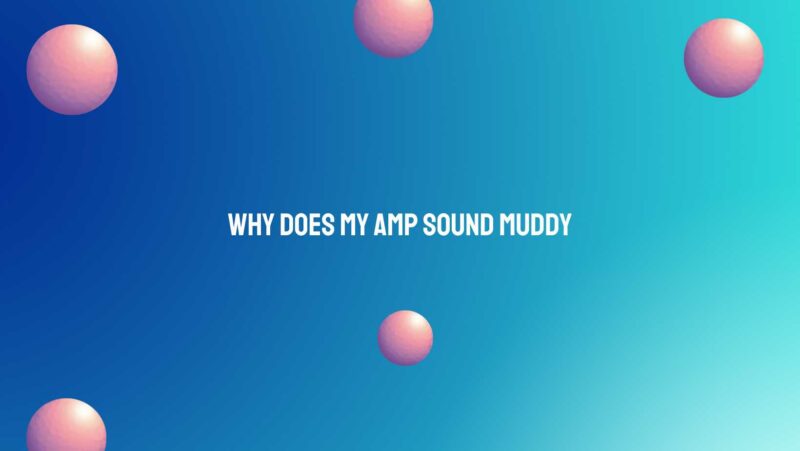As a guitarist, you may have encountered the frustrating issue of your amplifier producing a muddy, unclear, or indistinct tone. A muddy sound can rob your music of clarity and impact. In this comprehensive article, we will explore the common reasons why your guitar amp might sound muddy, how to identify the issue, and practical solutions to restore the clarity and definition of your amplifier’s sound.
Why Does My Amp Sound Muddy?
- Improper EQ Settings:
One of the most common causes of a muddy amp sound is incorrect equalization settings. If your amp’s EQ (equalization) controls, such as bass, midrange, and treble, are not properly adjusted, it can lead to a muddled and unbalanced tone. Too much bass or a lack of treble can contribute to muddiness.
- Excessive Gain or Distortion:
Overdriving your amp with excessive gain or distortion can create a muddy tone. While distortion can be desirable in certain genres, too much of it can result in a loss of clarity and definition.
- Speaker and Cabinet Issues:
The quality and condition of your amplifier’s speaker and cabinet can greatly affect your tone. Old or damaged speakers, or mismatched speaker types, can produce a muddy sound. Additionally, improper cabinet construction and size can impact the overall clarity of your amp’s sound.
- Inadequate Tube Maintenance:
If your amp uses vacuum tubes (valves), neglecting tube maintenance can lead to a muddy tone. Tubes that are failing or worn out can produce distorted and murky sounds.
- Guitar and Pickup Choice:
The type of guitar and pickups you use can also contribute to a muddy tone. Humbucker pickups, for example, can produce a warmer and thicker sound, which might become muddy if not properly balanced.
- Pedalboard Chain and Effects:
The order and choice of effects pedals in your signal chain can impact your amp’s tone. Incorrect placement or an excessive number of effects can lead to muddiness.
- Room Acoustics:
The acoustic characteristics of the room in which you’re playing your amp can affect the sound. Reflections, resonance, and room size can all contribute to a muddy or unclear tone.
Identifying a Muddy Amp Sound
Before addressing the issue, it’s crucial to identify when your amp sounds muddy. Here are some signs to help you recognize this problem:
- Lack of Clarity: The sound coming from your amp lacks clarity, making it challenging to distinguish individual notes and chords.
- Reduced Definition: Chords and individual notes played on your guitar become less defined, with less separation between each note.
- Excessive Bass Response: The low-frequency response from your amp is overpowering, resulting in a boomy and unclear tone.
- Muffled Sound: Your amp produces a sound that seems trapped or muffled, with limited brightness and presence.
Solutions for a Muddy Amp Sound
To restore clarity and definition to your amplifier’s sound, consider these practical solutions:
- Adjust EQ Settings:
Start by fine-tuning the EQ controls on your amp. Reduce excessive bass and experiment with boosting treble and mids to achieve a clearer, more balanced tone.
- Control Gain and Distortion:
Carefully adjust the gain or distortion levels on your amp. Find the sweet spot that provides the desired level of saturation without sacrificing clarity.
- Check Your Speaker and Cabinet:
Ensure that your amp’s speaker is in good condition and properly matched to the cabinet. Consider upgrading to higher-quality speakers if necessary.
- Tube Maintenance:
Regularly check and replace worn or failing tubes. Proper tube maintenance can significantly improve the overall tone and clarity of your amp.
- Evaluate Guitar and Pickups:
Experiment with different guitars and pickups to find a combination that balances warmth and clarity. Adjust pickup height if necessary.
- Optimize Pedalboard Chain:
Review the order of your effects pedals in the signal chain and eliminate unnecessary or redundant effects that may contribute to muddiness.
- Room Treatment:
Consider improving the acoustics of your practice or performance space with acoustic treatment. This can help reduce unwanted reflections and enhance clarity.
- Professional Assessment:
If you’ve exhausted all other options and your amp still sounds muddy, consult a professional technician or luthier. They can diagnose and address more complex issues with your amplifier.
Conclusion
A muddy amp sound can be a frustrating obstacle for guitarists, but understanding the potential causes and how to address them can help you achieve the clarity and definition you desire in your tone. Whether it’s adjusting EQ settings, controlling gain, checking your speaker and cabinet, maintaining your tubes, optimizing your guitar and pickups, or evaluating your pedalboard chain and room acoustics, there are practical solutions to ensure your amplifier produces a clear and impactful sound. With patience and attention to detail, you can unlock the full potential of your amp and enjoy the rich and distinct tones it is capable of delivering.

